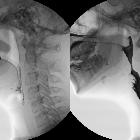Robin sequence



Robin sequence, also called Pierre Robin syndrome or Pierre Robin anamaloid, is a congenital condition characterized by facial abnormalities. Its etiology has no genetic base, but rather, is reliant on a sequence of events, one following the other.
Terminology
Robin sequence is the preferred term rather than Pierre Robin syndrome, as most cases are not syndromic .
Epidemiology
Robin sequence occurs in 1 in 8500 neonates .
Clinical presentation
May present with upper airway obstruction, sleep disturbance or apnea.
Pathology
The primary defect is a retrognathic mandible which occurs at 7-11 weeks of gestation due to abnormal development of the first pharyngeal arch (see branchial apparatus). This prevents the tongue from descending which in turn prevents fusion of palatal shelves resulting in glossoptosis (retraction of tongue), high or U-shaped palate and airway obstruction. It is characterized by
- micrognathia
- glossoptosis
- posterior cleft palate or high arched palate
Genetics
Most cases tend to be sporadic.
Associations
- Stickler syndrome
- femoral facial syndrome
Radiographic features
Antenatal ultrasound
A sagittal fetal facial profile may show severe micrognathia. Ancillary sonographic features include
- polyhydramnios: from impaired swallowing from micrognathia
Complications
Severe micrognathia may lead to
- obstruction of fetal swallowing: may in turn cause polyhydramnios
- airway obstruction: may, in turn, lead to postnatal hypoxia
Siehe auch:
- Polyhydramnion
- Mikrognathie
- Stickler-Syndrom
- Gaumenspalte
- Obstruktion obere Atemwege
- Carey-Fineman-Ziter-Syndrom
und weiter:

 Assoziationen und Differentialdiagnosen zu Pierre-Robin-Sequenz:
Assoziationen und Differentialdiagnosen zu Pierre-Robin-Sequenz:



